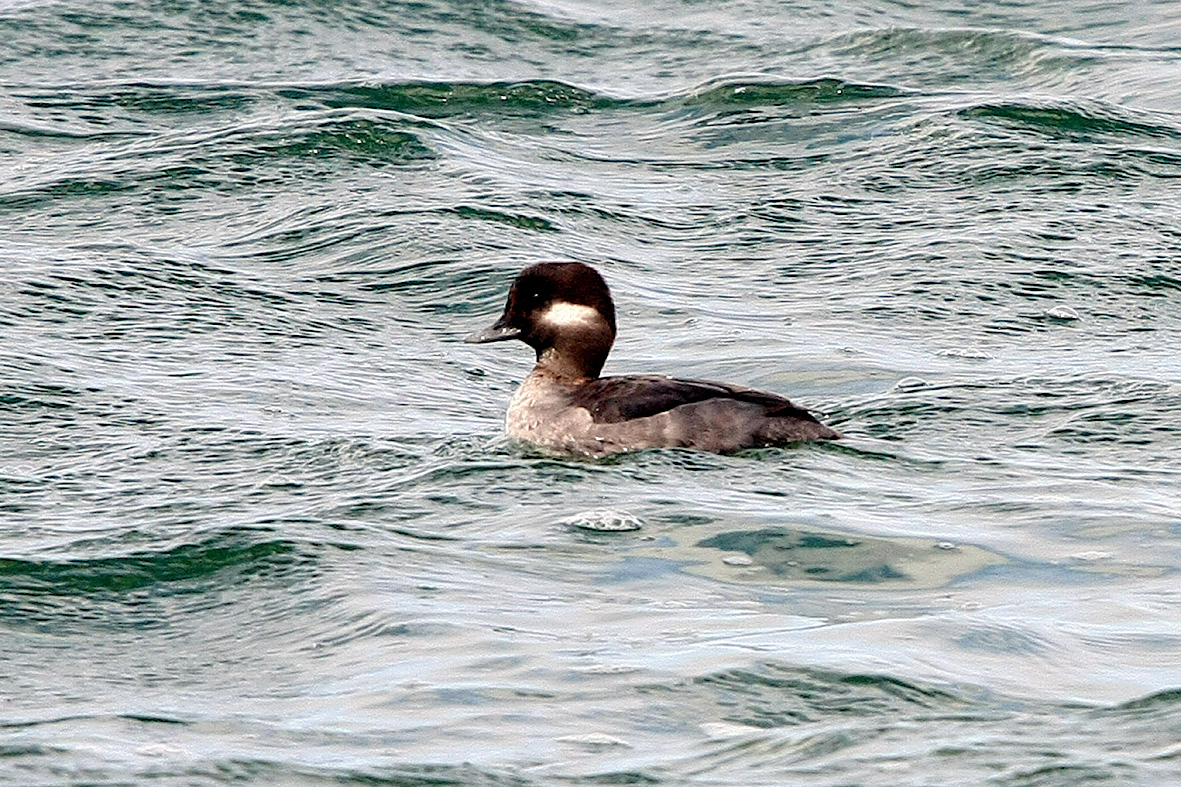Bufflehead Bucephala albeola
Vagrant, North America.

Bufflehead at Covenham Reservoir, April 27th 2012; photo courtesy of Roy Harvey
A female/immature bird was at Covenham Reservoir on April 27th 2012 and represented the first record for the county and 16th for Britain. Known escapes from captivity included a female which frequented Huttoft Pit 2002-05, and more recently another female, an adult, at Baston and Langtoft GP on March 30th 2019. This latter bird was ringed and had been seen elsewhere in the East Midlands.
There have been 16 accepted British records 1950-2018 including three males in the spring of 2004. All but three of the previous records have been since the well-watched drake at Colwick Country Park March 17th-26th 1994. November appears to be the best month for vagrant Buffleheads with four records. As ever, wild origin is often difficult to prove in unringed birds but the surge in records of other Nearctic duck species such as American Wigeon, Mareca americana, Green-winged Teal, Anas carolinensis and Ring-necked Duck, Aythya collaris from the late 1990s provides some evidence for wild origin, although some might disagree.
| Site | First date | Last date | Count | Notes |
| Covenham Reservoir | 27/04/2012 | 1 | Age/sex uncertain, possibly an immature or female |
Finder’s report: Bufflehead at Covenham Reservoir, April 27th, 2012, first county record
by G. Langan
Note: This account is based on the original BBRC submission by the finder. The BBRC report for 2013 explained that based on current knowledge of plumage it was not possible to accurately age or sex this bird (although clearly not an adult male). A second bird had been present in the UK in Cornwall from October 26th, 2011, until March 4th, 2012. Careful examination of photographs suggested that this was a different individual.
Circumstances
The weather in the first part of the morning had been poor with more or less constant heavy rain but by 10.45 hr. it had stopped, and I decided to go for a quick walk around Covenham Reservoir before setting off for a family trip to Wales. It was now overcast with 80% cloud and a force 4 N wind, but with good visibility. I arrived on site and noticed some ducks close to the southern edge of the reservoir busily feeding. One of these birds was noticeably smaller to the naked eye. The firs bird that I looked at with my binoculars was the Bufflehead. I watched the bird for 15 minutes before telephoning Keith Robinson to tell him of the birds presence. He was just about to set off for the reservoir and was watching the bird with me 20 minutes later. The bird was observed using 10x40 Zeiss binoculars and a Bausch and Lomb 15-60x60 telescope down to a distance of 30m.
I continued to walk around the reservoir after watching the bird for just over an hour. By the time I arrived back at the southern entrance where I began my walk about five other birders were present watching the Bufflehead. It continued to show for the rest of the day, but was not present on the next day.
Description
General
The bird appeared obviously smaller than the five Tufted ducks it was loosely associated with. All were busily diving and this and the fact that the bird was very flighty allowed for excellent views. It was restless the entire time that I watched it and enjoyed raising itself up and vigorously flapping its wings every 20-30 seconds.
Head – head was dark brown with a white, roughly rectangular patch, largely below and behind the eye. It’s bill was dark grey and of a similar structure to a Goldeneye but much smaller.
Upperparts – dull brown, greyer brown on the rump, uppertail coverts, undertail, flanks, sides of breast and neck. The upperwing was dullish brown with white secondaries and some greater coverts, and the subtly weak and narrow primaries suggest a first winter bird, and the extent of the white markings on the upperwing suggest that this bird may be a male.
Underparts - the centre of the underparts was generally whitish-grey. The underwing was brown with predominantly white coverts.
(Account as per new Birds of Lincolnshire (2021), included September 2022)

